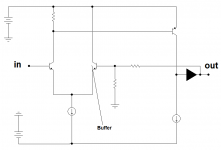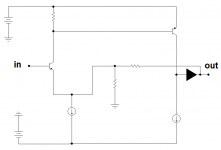janneman said:
Not needed.
Did you use this circuit in this form for audio apps?
mikeks said:
What on earth are on about?
That I and others have talked for many pages about the theoretical model of the unity gain buffer, and then it suddenly turns out that your arguments are based on not accepting the usual definition of it, without having said so. Fine, use your own definition, but realize that you might get different results and reach different conclusions that way. That doesn't mean either of us is wrong, we just started from different premises, but you seem to think we others must be wrong since we didn't start from your premises. This whole VFB/CFB issue is obviously, as I have said several times, not really about who is right or wrong, but about how we prefer to define and name things, and in that there is no right or wrong. I have not been trying to claim that you are wrong, just figure out what you mean, especially when you say that others are wrong.
Mikeks,
Regarding the two schematics you just posted. It is still the case that even if we assume the transistor is a theoretically perfect transistor behaving according to the first-order model, it will not have the properties of a theoretical perfect unity gain buffer, but have som output impedance, a gain slightly less than 1 etc., so it is not quite the same as the theoretical CFB op amp as used in most papers. Most would probably conisder it as a practical implementation of CFB, assuming component values that makes it approximate the theoretical model.
However, if considering it as a practical implementation, you make a good point by referring to the second transistor in the diff pair as a buffer. What you do here is basically the same thing National does when they turn the 6181 CFB op amp into the 6171 VFB op amp. That would mean that we suddenly view the usual diff pair as two buffers fighting each other, which seems perfectly all right. There are usually many ways to look at the same thing.
Regarding the two schematics you just posted. It is still the case that even if we assume the transistor is a theoretically perfect transistor behaving according to the first-order model, it will not have the properties of a theoretical perfect unity gain buffer, but have som output impedance, a gain slightly less than 1 etc., so it is not quite the same as the theoretical CFB op amp as used in most papers. Most would probably conisder it as a practical implementation of CFB, assuming component values that makes it approximate the theoretical model.
However, if considering it as a practical implementation, you make a good point by referring to the second transistor in the diff pair as a buffer. What you do here is basically the same thing National does when they turn the 6181 CFB op amp into the 6171 VFB op amp. That would mean that we suddenly view the usual diff pair as two buffers fighting each other, which seems perfectly all right. There are usually many ways to look at the same thing.
mikeks said:
What for?
I have been using it to see how it would work as an open loop gain stage. The source output Z sets the input current and the output load resistor then sets the gain. Works like a charm, no oscillations, no compensation, extremely wide bandwith, clean clipping, what have you. The only drawback is that the linearity is below par compared with a traditional feedback amp.
But! You add error correction, and all of a sudden it looks MUCH better.
Jan Didden
mikeks said:So-called 'CF'
Ah, but you've done a sneaky thing by getting rid of the current source that was in the tail of the LTP. (you've bypassed it with a resistor). Just sit down and analyse what that does to the O/L transfer function.
Christer said:.......view the usual diff pair as two buffers fighting each other.........
No.
http://www.diyaudio.com/forums/showthread.php?postid=422430#post422430
mikeks said:
So, first you tell me you think the emitter follower is a buffer. Then you add another emitter follower, which you also call a buffer, and you end up with a diff amp. One plus one is two, as long as we don't redefine the usual mathematical symbols. How am I to interpret your exercise other than that a diff pair actually is a combination of two buffers? I still haven't learnt to read you mind, Mike. Expressing yourself in longer sentences than one word will probably help.
mikeks said:Christer....are you writing this :bs: on purpose?
Yes, it is basically all with the purpose to figure out what you really want to say, but seem to fail to communicate to us. I am not doing it to say that you are wrong or stupid or anything, just too see if you really have something to add to the topic that all we others fail to see. I really do wonder if you have actually understood much of what I and some others have written in this thread. Often it seems as if you have not even read my posts when you comment on them. Not sure I have the patience to go on with this any longer, despite getting emails encouring me to go on from people who have got tired of discussing with you at earlier occasions.
Edit:
Or maybe you understand better if I simply answer your question with "No"? 😉
Christer said:So, first you tell me you think the emitter follower is a buffer....
Christer, when and where did i say this?

mikeks said:
Christer, when and where did i say this?
OK, that was my attempt at guessing what you would have said if you had had the courtesy to write some text to explain what the purpose with posting the two schematics was. So if that was not what you meant, then the purpose of posting those schematics is even less comprehensible to me, since we still lack an explanation. Maybe you should start by answering Ourbouros' question, though.
I am dead tired of always having to guess what you mean. I am not saying this to be rude, but rather to be helpful, but you really ought to work on your communication skills. Nobody seems to think it is possible to have a constructive discussion with you. We can only guess if the problem is lack of ability to communicate what you want to say or if it is to hide that you have nothing to say. I don't want to assume the latter is the case, which is why I bother to try discussing with you. But it seems to lead nowhere. I feel like the main character in John Fowles book "The Magus". Whenever I think I start to understand you, you make a 180 degree turn and leave me even more puzzled.
Christer said:OK, that was my attempt at guessing what you would have said ........
:bs:
mikeks said:
:bs:
Is that the most intelligent answer you can come up with? I think my guess was a fair one considering what we had discussed, but maybe you just ignored what we were discussing and decided to post some schematics for some other, untold, purpose? Why is it you almost always change topic when somebody asks you a question?
For the last time...
Christer...
Christer...
The key difference being that with so-called 'current feedback', the feedback voltage is applied to directly to the emitter of the subtracting transistor........while with the usual diff. input stage, the feedback voltage is buffered from the emitter of the subtracting transistor by an emitter follower...
Re: For the last time...
Yes, but that is your definition of current feedback, and I thought I had explained enough times that I do not use your definition, but the one used in for instance the app. notes I linked to. It is absolutely pointless to argue about my claims if you do not argue from the same definitions as I do. I thought I had made that clear several times too.
The problem is that you seem to refuse to accept that most people use different definitions than you and continue to interpret people according to the definitions you prefer, which obviously is not sensible to do. And even if only a few of us used different definitions and most agreed with you, it wouldn't change anything. If we draw correct conclusions from our definitions, then they are correct, even if they do not follow from your definitions.
mikeks said:Christer...
Yes, but that is your definition of current feedback, and I thought I had explained enough times that I do not use your definition, but the one used in for instance the app. notes I linked to. It is absolutely pointless to argue about my claims if you do not argue from the same definitions as I do. I thought I had made that clear several times too.
The problem is that you seem to refuse to accept that most people use different definitions than you and continue to interpret people according to the definitions you prefer, which obviously is not sensible to do. And even if only a few of us used different definitions and most agreed with you, it wouldn't change anything. If we draw correct conclusions from our definitions, then they are correct, even if they do not follow from your definitions.
Many people are not really interested in believing the truth, and to make that clear, they declare: 'I am entitled to my opinion'.
You should realise it is simple rudeness to persist; YOU may be interested in whether their opinion is true, but take the hint, THEY aren't." - Jamie White, Crimes Against Logic, McGraw Hill, 2005.
Bye Christer..🙄
- Status
- Not open for further replies.
- Home
- Amplifiers
- Solid State
- Current feedback - not suitable for audio ?

